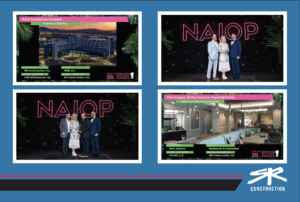An article by Bret Loughridge, Vice President of Operations, was published in Construction Business Owner magazine’s March issue!
“Why Your Company Needs a Lean Building Program” discusses how you can refine your workplace, eliminate redundancies, and train staff to recognize and reduce waste in all business practices.
Why Your Company Needs a Lean Building Program
Refine your workplace, eliminate redundancies, train staff to recognize & reduce waste in all business processes
As many companies look for ways to improve internal and external operations for the current surge in building, expansions, and improvements, numerous programs like lean construction come to the forefront with their proven effectiveness. The Lean Construction Institute (LCI) was founded in 1997 to improve the construction and design industries through Lean approaches to project design and delivery.
According to the LCI, lean methods seek to develop and manage a project through relationships, shared knowledge, and common goals. Traditional silos of knowledge, work, and effort is broken down and reorganized to better the project rather than individual participants. Furthermore, eliminating wasted time, movement, and human potential results in better time productivity, reduced safety hazards, and cost savings to all parties involved in the project.
When a lean program is implemented on a construction project, the process incites actions that continuously enhance all functions and include all stakeholders, from the company’s head to the trade partners. It also applies to the processes, such as procurement, logistics, and the cross-organizational lines into the supply chains.
By improving standardized activities and operations, lean strives to reduce waste. When done correctly, it also refines the workplace, eliminates redundancies, and trains the staff to recognize and reduce waste in all business processes.
The method suggests a tempered approach to workers, thus increasing productivity. The idea is to train the team as much as it is to praise and encourage participation in lean activities. Successful implementation requires workers’ engagement in the development, involving all levels of an organization to participate, from the chief executive officer (CEO) to everyday staff and outside stakeholders.
Regardless of the contractual relationship, it is essential to drive innovation, collaboration, and teamwork and hold all stakeholders accountable for appropriate behaviors that support each project’s mission and goals. By adopting the core principles of Lean construction, this can be done effectively. The primary foundational values of lean—respect for people and the elimination of waste—create a consistent and productive atmosphere where safety, productivity, teamwork, and flow can be significantly improved.
General contractors (GCs) take on the role of partner to the client to provide creative and adaptive planning, design, and construction solutions that coincide with the clients’ company culture, business, and community.
That said, no two projects are the same, and helping clients choose the best project delivery method on a case-by-case basis is the key to success. With careful evaluation of the most important standards to each project’s success and an in-depth understanding of the models available, the GC assists the client in making informed decisions that are right for its unique needs.
By selecting the appropriate contract relationship for the client’s needs, the process can be optimized so that the client will experience improved forecasting, cost reliability, and on-time completion, taking away any worries regarding the project’s construction.
Today’s lean philosophy is focused on five principles and a wide variety of practices that have been derived from Toyota’s production system and the methods of other companies since its inception.
The five principles are identified as value, value stream, flow, pull, and constant improvement. The first principle is centered around the customer defining what is of value. Once the team understands the customer’s values in the product, the team can then create a value stream map that identifies a set of actions required to deliver the product. Each level is classified as either value-added, non-value-added but essential, or non-value-added but waste.
The process must then be designed to flow continuously. If the value chain stops progressing for any reason, succeeding waste is transpiring. The next principles are focused on the process of letting requests pull results for the value. This pull trickles down through the value stream and ensures that nothing is made before needed, thus eliminating most in-process production. The final principle is to strive for constant improvement by continuously recognizing and removing waste.
SR Construction applies an Integrated Project Delivery (IDP) System, also known as Lean Construction, a management-based approach that increases efficiency and eliminates waste during all phases of a project.
The project team collaborates throughout the project duration and comprises a lead representative from each entity, the owner, architect, general contractor, engineer, relevant manufacturers, consultants, and trade partners. Instead of focusing independently on a specific part of the process, the IDP team works together to harness all team members’ strengths, resulting in a better value for the client, improved schedule, reduced costs, and a more enjoyable experience.
“Pull planning” is just one part of the Last Planner System and an example of how the collaborative and lean approach pays dividends for the team. The direct engagement of field foreman and those knowledgeable of activity requirements and durations ensures that reliable commitments are made in the planning process. Regular planning sessions allow the team to adjust the course in real-time based on constraints and opportunities to optimize the plan moving forward.
Opposed to the typical approach of establishing a rigid environment and pushing unwilling participants towards the finish line, the pull planning approach directs the responsibility and accountability to those involved in the execution of the work. Schedule reductions of 10 to 30 percent are typical.
To make a lean program work, teams need to become self-directed, allowing constraints to be resolved from within the groups rather than management tasked with delegating issues to various team members. Lean requires a shift in thinking and a collaborative effort to ensure that everyone is properly trained. Lean is centered around gaining knowledge by taking action. According to the LCI, the early stages of Lean transformation require 80-percent doing and 20-percent training and informing.
To ensure that the training is effective and correlates to real-world situations, there must be an experienced and skilled facilitator who has profound knowledge of the Lean tools and philosophy. Leadership must stay focused on long-term learning and prepare for middle management resistance, which can be mitigated through open communication and mutual feedback. Attention and energy to eliminate non-lean metrics are a necessity.
Hiring or cultivating leaders is crucial in creating a core group of well-trained people in the lean implementation process and procedures that follow and can help others create lean processes through their education and experience.
All of this requires patience, which is vital in getting results and creating a supportive environment. Lean also requires the courage to take risks at critical stages to drive resources to meet objectives and achieve optimum results. Lean is a journey, not a point in time, guided around the principle of continuous improvement.
Bret Loughridge is the vice president of operations at SR Construction. SR Construction is a Las Vegas, Nevada-based, full-service design/build general contracting company. SR Construction was founded in 1991 and has fully embraced the Lean process throughout its internal and external processes.



